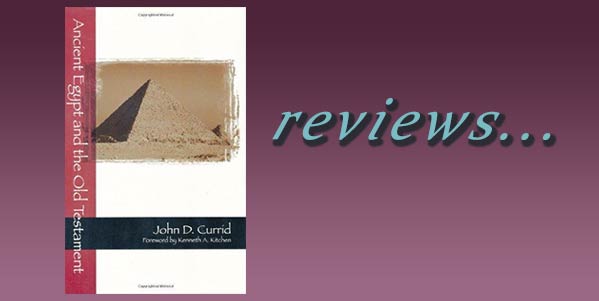John D. Currid, Baker Books, Grand Rapids, 1997
Reading this book has been really eye opening. As someone who has always nurtured an interest in ancient Egypt, but have been rarely with any opportunity to express it, I could hardly contain my anticipation on opening it. Currid is an associate professor of Old Testament, and holds a Ph.D in archaeology. It is clear right through the text that he is driven by a desire to follow where the various sources lead, and is not on a mission to prove that the Old Testament says more (or less) than the authors intended.
At the start Currid takes the bull by the horns and looks at an issue that is “most troubling” or “nagging” for Biblical Scholars. [27]

I’d suggest that is indeed not just a difficult issue for “professional” theologians; it has certainly played on my mind too. If you spend any time on the internet, with National Geographic or the History Channel, it is likely that you have come across ideas which run like this. The writer, of say, the biblical account of “Noah’s Flood” clearly stole it from some other culture ~ namely the Mesoptomian epic of Gilgamesh which predates the Genesis account by several centuries, removing some of the ‘distasteful’ theological concepts and generally tidying it up for Hebrew audience.
Rather than simply dismissing one side of the argument, Currid sets the tone for the rest or the book as he synthesises the ideas from many and various sources into a coherent and easily accessible summary of different positions. He suggests a meaningful alternative such that I came away from this section with a sense that I was being thrown a viable life-jacket to keep me from drowning in the sea of intellectual suicide that I sometimes feel Christians are expected to swim in.
The second section deals with Egyptian influences in the Pentateuch, which for me contained the highlights of the book. One or these involved an in-depth look at the “snake based” confrontation between Moses and Pharaoh’s magicians which Currid says is essential to understanding the plagues and exodus which follow it. Snakes played a significant role in Egyptian religion being seen as “friend and fiend, protector and enemy , and the personification of the sacred and the profane.” [88] Additionally Pharaoh was given power by the snake Goddess to rule Egypt. Given this, the swallowing up of Pharaoh’s snake by Yahweh’s takes on added significance.
This leads, via a discussion of the court magicians ability to create snakes, onto an analysis of the plagues. Neither the “Literary invention” or the “Natural disasters” understandings do justice to the text. Currid identifies the plagues as attacks by Yahweh on specific Egyptian gods, as ever using a range of sources from intertestamental writings and The Pyramid Texts, through to modern scholars. [108] As well as this, the plagues are described as being a ‘de-creation’ [115] and an attack on the divine nature of Pharaoh. I was left with a profound sense of the deconstruction of the Egyptian religious life, its gods and its pharaoh.
On two occasions I found myself disengaging with the content. A discussion of the Exodus route of which only about 25% of the places mentioned can be positively identified became too technical for me. I do not doubt however that this is useful materiel for the right audience. The same is most likely true for the section on the Bubastite Portal, which sadly does not appear to be a form of ancient technology.
Sections on the Historical, Wisdom and Prophetic books follow. These are shorter but still very engaging. Again we see there are clear cases where the biblical text is influenced by Egyptian culture. Egyptian flavoured evidence is presented for the united kingdoms of David and Solomon [159] and the marriage of a daughter of Pharaoh. [162] A discussions on the extent that Jewish writers copied the wisdom literature of Amenemope, an Egyptian official, ends by suggesting that this is less “Cras plagiarism” and more due to ” a general familiarity.”with the genre. [216]
The book ends with a powerful description of the linkage between the divine nature of the river Nile and Pharaoh. Thus it was Pharaoh who bought life to the land via the yearly flooding. This helps us see the meaning behind the various “I will dry up the Nile” style Hebrew prophecies. Again, these can be seen as an attack on the promotion to deity status of created things and a challenge to who it is who really rules the natural order. [245]
This is a highly recommended book; not only is it written by an expert, but it is widely referenced and big questions are tackled head on. I really enjoyed having the Egyptian influences bought to the fore, most of which had never crossed my radar and which bring new clarity to the narratives in the Hebrew Bible. Bringing out the themes regarding divinity, idolatry, and the links between cultures helps to build the sense of coherence with the Old Testament. Once or twice the content was too technical, but that surely says more about me than the book. I am left hungry for me.



